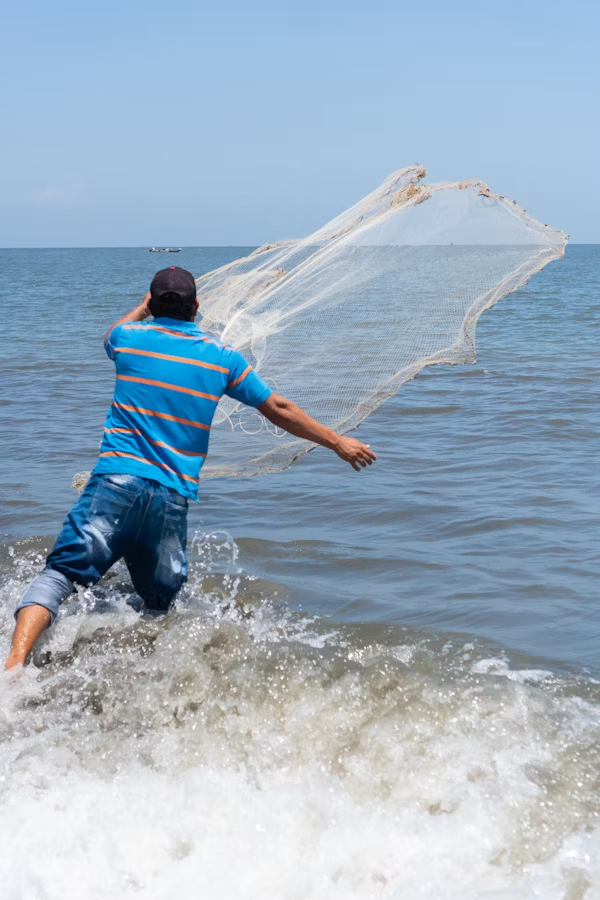Introduction: Our Oceans’ Phantom Threat
More marine deaths are caused by an invisible killer beneath the ocean’s surface than by plastic straws or oil spills combined. A deadly byproduct of the fishing industry itself, abandoned, lost, or discarded fishing gear—also referred to as “ghost gear”—poses a threat instead of being a chemical or a pollutant in the conventional sense.
An estimated 640,000 tonnes of fishing gear, such as nets, lines, traps, and pots, are dumped into the ocean annually. These abandoned instruments become lifelong killers that trap fish, turtles, seals, whales, dolphins, and turtles in a cycle of death that can go on for decades. The devastating effects, intricate causes, and international efforts to recover this lethal debris from the deep are all covered in this 2,500-word investigation into the silent crisis of ghost gear.
1. The Problem’s Scope: An International Overview
The most dangerous type of marine plastic debris is ghost gear. It is particularly destructive long after it is gone because of its ability to catch and kill.
A. Derelict Gear’s Deadly Statistics
| Type of Ghost Gear | Primary Impact | Estimated Lifespan in Ocean |
| Gillnets | Large, invisible walls of netting that entangle anything that swims into them. | Up to 500-600 years (as plastic microfibers) |
| Fish Aggregating Devices (FADs) | Man-made objects that attract fish, often made with netting; frequently abandoned. | Varies; netting components persist for centuries. |
| Crab Pots & Traps | Continue to capture and kill target and non-target species (bycatch) indefinitely. | Metal parts rust, but plastic components last for hundreds of years. |
| Longlines | Monofilament lines with hundreds of baited hooks that can stretch for miles. | Can snag on reefs and continue fishing for years. |
B. Ghost Gear Hotspots
- Although ghost gear can be found in all oceans, it is most prevalent in fishing grounds. Important hotspots consist of:
- Up to 46% of the plastic mass in the North Pacific Gyre (Great Pacific Garbage Patch) is made up of fishing gear.
- Southeast Asian waters, where waste management infrastructure is frequently deficient and fishing is a significant industry.
2. The Death Cycle: How Ghost Gear Causes Death
The way these nets continue to catch marine life on their own is exactly what is meant by the term “ghost fishing.”
- Death and Entanglement: A drifting net entangles a whale. It exhausts itself dragging the heavy equipment, which can result in starvation, drowning, or serious injuries from the net slicing into its flesh.
- The Bait Cycle: Sharks and other scavengers are drawn to the dead whale and entangle themselves. A single net can kill indefinitely because of this horrific cycle.
- Habitat Destruction: Diffuse coral reefs and seabeds are snagged by heavy nets, which crush the structures and suffocate ecosystems. The nets add to the microplastic problem as they decompose.
- Ghost gear is indiscriminate, which is the Bycatch Tragedy. Millions of animals that are not the target of fisheries are killed by it, including sea turtles, seabirds, and endangered species like the North Atlantic right whale, of which less than 360 are left.
What Causes Gear Abandonment? The Fundamental Reasons
A number of factors combine to cause fishing gear loss, which is rarely intentional.
- Weather and Accidents: Equipment may become snagged on underwater obstacles or cut loose due to storms, strong currents, and accidents, making retrieval risky or costly.
- Illegal, Unreported, and Unregulated (IUU) Fishing: When fishing illegally, vessels may leave their gear behind in order to evade detection or because it is damaged.
- Absence of Port Reception Facilities: In many regions of the world, fishermen are driven to dump old, damaged nets at sea because there is no affordable or legal way for them to be disposed of on land.
- Conflict: When several boats fish in the same spot and lines tangle, gear is frequently lost.
Remedies: Dismantling the Destruction Networks
From prevention to retrieval, a multifaceted strategy is needed to address the ghost gear crisis.
| Solution Category | How It Works | Key Examples |
| Prevention | Stopping gear from being lost in the first place. | Biodegradable Gear: Developing nets that break down after a set time if lost. GPS Marking: Tagging gear with low-cost GPS transponders for easy recovery. Fisher Incentive Programs: Paying fishers to return damaged gear to port. |
| Mitigation | Reducing the impact of gear that is lost. | Solution Category How It Works Key Examples Prevention Stopping gear from being lost in the first place. Biodegradable Gear: Developing nets that break down after a set time if lost. GPS Marking: Tagging gear with low-cost GPS transponders for easy recovery. Fisher Incentive Programs: Paying fishers to return damaged gear to port. Mitigation Reducing the impact of gear that is lost. |
| Retrieval | Actively removing ghost gear from the ocean. | The Ocean Cleanup’s System 03: A large-scale system designed to recover plastic, with a focus on ghost nets. Global Ghost Gear Initiative (GGGI): A coalition of governments, NGOs, and companies working to map, retrieve, and recycle ghost gear. |
| Recycling & Circular Economy | Turning recovered gear into new products. | Net-Works Program: Collects discarded nets from communities and recycles them into nylon for carpets and other products. Bureo: Recycles fishing nets into skateboards, sunglasses, and other consumer goods. |
The Path Ahead: An Appeal for International Intervention
The ghost gear issue can be resolved, but it will take a coordinated global effort.
- Strengthening International Law: Although the MARPOL treaty already forbids the wilful disposal of plastic at sea, its enforcement is lax. It is essential that port states ratify the IMO’s fishing gear marking guidelines and enforce stricter controls.
- Corporate Responsibility: As part of their sustainability pledges, major seafood consumers and brands are putting more and more pressure on their suppliers to implement best practices to reduce gear loss.
- Supporting Fishermen: Since fishermen are both a contributing factor to the issue and a key component of the solution, they must be included in any solutions. It’s crucial to give them the infrastructure, financial incentives, and technology they need to properly manage their equipment.
FAQs
For hundreds of years, a fishing net made of contemporary plastic can continue to ghost fish. It only stops when it sinks to the ocean floor, is physically removed by humans, or is too heavily weighed down by catch to float. It continues to pose a threat even as it photodegrades and transforms into microplastics.
Cleanup is not nearly as effective as prevention. Preventing the loss of nets is more cost-effective, secure, and environmentally friendly than recovering them from the deep ocean. The most effective approach is to invest in improved port facilities, marking, and equipment technology.
Yes, and the industry is expanding. Fishing net nylon can be recycled into premium pellets that are used to create new items like skateboards, sportswear, swimwear, and carpets. The establishment of a market for repurposed ghost gear offers financial motivation for its acquisition.

